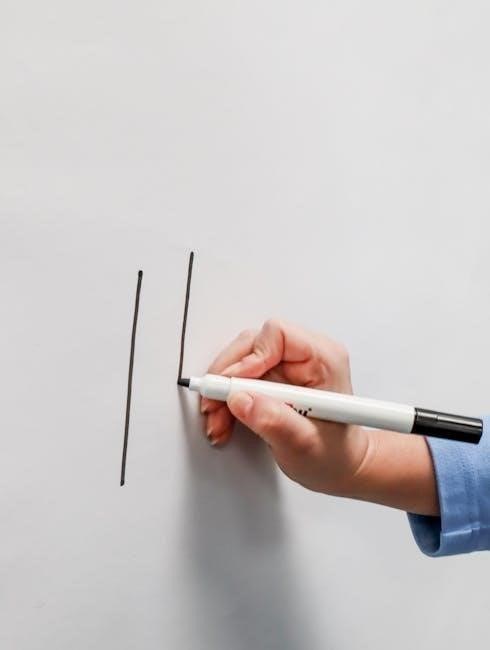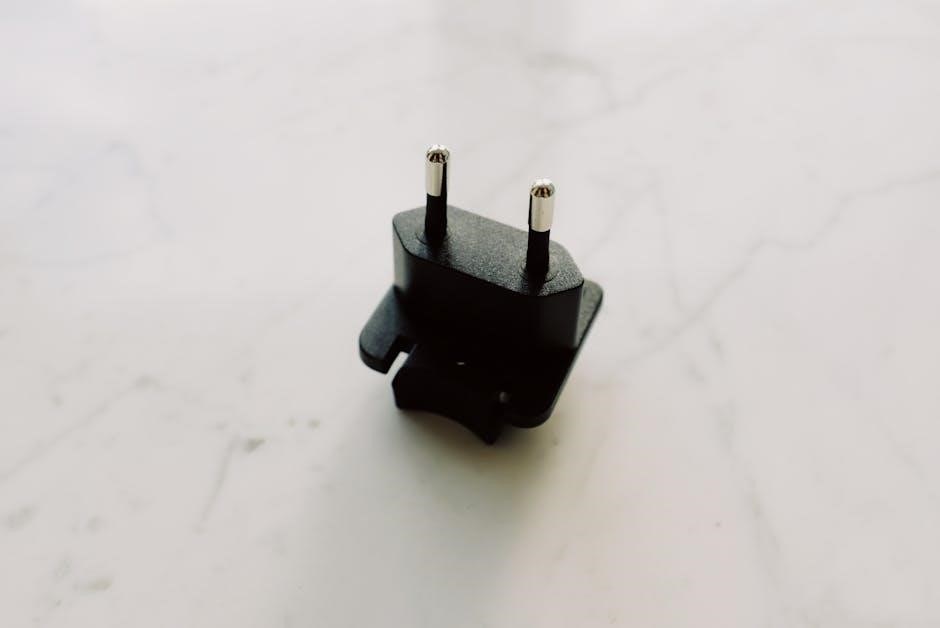PDF and CDR are popular file formats with distinct purposes. PDF is ideal for sharing documents‚ while CDR is CorelDRAW’s native format for vector graphics and detailed editing.
What is a PDF File?
A Portable Document Format (PDF) file is a widely used format for sharing and viewing documents while preserving their layout‚ fonts‚ and graphics. Created by Adobe‚ PDFs are ideal for distributing content securely‚ as they cannot be easily edited. They support text‚ images‚ and vector graphics‚ making them versatile for various purposes‚ including professional documents‚ e-books‚ and forms. PDFs are platform-independent‚ meaning they can be opened on any device with a PDF reader. Their fixed layout ensures consistency across different screens and printers. While PDFs are great for sharing‚ they are not designed for editing‚ which often leads users to convert them to formats like CDR for detailed modifications. This limitation highlights the need for reliable conversion tools to unlock PDF content for further creative or professional use.
What is a CDR File?
A CDR file is the native format of CorelDRAW‚ a powerful vector graphics editor. It stores vector images‚ text‚ and metadata‚ ideal for professional graphic design. CDR files allow precise editing of elements like shapes and text‚ making them perfect for logos‚ brochures‚ and intricate designs. Unlike raster formats‚ CDR files maintain quality at any scale‚ essential for high-resolution outputs. They are widely used in advertising‚ signage‚ and digital art. While CDR files are specific to CorelDRAW‚ they can be exported to other formats for broader compatibility. Their ability to preserve editability makes them a preferred choice for designers needing detailed control over their work.
Importance of Converting PDF to CDR
Converting PDF to CDR is essential for designers and professionals who need to edit vector graphics and text with precision. PDFs are ideal for sharing but lack editability‚ while CDR files allow detailed modifications in CorelDRAW. This conversion is crucial for projects requiring scalable vector graphics‚ as CDR maintains quality at any size. It enables designers to preserve layers‚ objects‚ and metadata‚ ensuring professional results. For those working with logos‚ signage‚ or high-resolution prints‚ converting PDF to CDR is vital for achieving precise control over design elements. This process bridges the gap between fixed-layout documents and editable vector formats‚ making it indispensable for creative workflows.

Why Convert PDF to CDR?

Converting PDF to CDR enables editing‚ preserves vector scalability‚ and ensures compatibility with CorelDRAW‚ making it ideal for professional design projects requiring precise control.
Editing Capabilities in CDR
CDR files offer advanced editing capabilities‚ making them ideal for graphic design projects. Unlike PDFs‚ which are primarily for viewing‚ CDR allows users to modify vector graphics‚ text‚ and shapes with precision. Designers can access layers‚ adjust colors‚ and manipulate individual elements effortlessly. This level of control is essential for creating professional-grade artwork‚ logos‚ and illustrations. CorelDRAW’s native format ensures that all design elements remain editable‚ preserving the integrity of the original work. By converting a PDF to CDR‚ users gain the flexibility to enhance and customize their designs‚ making it a crucial step for projects requiring detailed adjustments and high-quality output.
Vector Graphics and Scalability
CDR files excel in vector graphics‚ offering scalability without loss of quality. Unlike PDFs‚ which can become pixelated when enlarged‚ CDR retains sharpness and clarity at any size. This makes it ideal for designs requiring resizing‚ such as logos‚ banners‚ and signage. Vector graphics in CDR are composed of mathematical equations‚ allowing precise scaling and editing. This feature is particularly beneficial for professional designers who need to ensure their work looks flawless across various mediums. By converting a PDF to CDR‚ users can leverage these scalable vector graphics‚ ensuring their designs remain crisp and professional‚ even when scaled up or down. This capability is a key reason why designers often prefer CDR for projects that demand high-resolution output and flexibility.
Compatibility with CorelDRAW
CDR files are the native format of CorelDRAW‚ ensuring seamless compatibility and direct editing within the software. Converting a PDF to CDR allows designers to access CorelDRAW’s advanced tools‚ such as vector editing‚ layer management‚ and effects. This compatibility is crucial for professionals who rely on CorelDRAW for precise control over their designs. Unlike PDFs‚ which are often read-only‚ CDR files enable full creativity and customization. By converting to CDR‚ users can maintain design integrity and avoid compatibility issues when sharing files with others who use CorelDRAW. This direct integration makes CDR the preferred format for projects requiring detailed vector work and professional-grade editing capabilities.
Tools for Converting PDF to CDR
Various tools are available for converting PDF to CDR‚ including online converters‚ desktop software‚ and plugins‚ each offering unique features to suit different user needs and preferences.
Online PDF to CDR Converters

Online PDF to CDR converters are web-based tools that allow users to convert PDF files to CDR format without downloading software. These tools are accessible from any browser‚ making them highly convenient for quick conversions. Many online converters are free or offer basic services at no cost‚ appealing to individuals or small businesses with limited budgets. They often support multiple file formats and provide options for adjusting settings to ensure the best output quality. However‚ some tools may have limitations‚ such as file size restrictions or watermarks on the output. Additionally‚ privacy concerns may arise when uploading sensitive documents to third-party websites. Despite these drawbacks‚ online converters remain a popular choice for their simplicity and ease of use‚ especially for those who need occasional conversions without advanced editing capabilities.
Desktop Software for Conversion

Desktop software for converting PDF to CDR offers a reliable and powerful solution for users seeking precise control over the conversion process. These programs are installed directly on your computer‚ eliminating the need for internet connectivity and enhancing privacy. Many desktop tools‚ such as Adobe Illustrator or CorelDRAW itself‚ provide advanced features like layer editing‚ vector graphics manipulation‚ and customizable settings to ensure high-quality output. Some software also supports batch processing‚ allowing users to convert multiple files simultaneously. Additionally‚ desktop applications often offer better compatibility with CDR files‚ ensuring that the final result is ready for editing in CorelDRAW. While these tools may require a purchase or subscription‚ they are ideal for professionals who need consistent and high-quality conversions. They also provide greater security for sensitive documents compared to online converters.
Alternative Tools and Plugins
Beyond dedicated converters‚ alternative tools and plugins can help achieve PDF to CDR conversion. These include browser extensions‚ standalone plugins‚ or software add-ons designed for specific tasks. For instance‚ some graphic design programs offer plugins that enable direct import of PDF files‚ which can then be saved as CDR. Additionally‚ certain online platforms provide downloadable tools or scripts that automate the conversion process. These alternatives are often cost-effective and cater to users with specific needs. While they may lack the advanced features of dedicated converters‚ they are ideal for occasional use or for those who prefer lightweight solutions. Exploring these options can provide flexibility and efficiency‚ especially when working with unique file requirements or limited resources.

Step-by-Step Guide to Convert PDF to CDR
This guide provides a step-by-step approach to converting PDF files to CDR format‚ utilizing various tools for seamless editing in CorelDRAW environments while maintaining quality.
Preparing Your PDF File

To ensure a smooth conversion from PDF to CDR‚ proper preparation of your PDF file is essential. First‚ make sure the PDF is not password-protected‚ as this can hinder the conversion process. If the PDF contains vector graphics‚ it is ideal for editing in CDR. Organize the content by separating text‚ images‚ and graphics into layers if possible. Ensure all fonts are embedded in the PDF to maintain text integrity during conversion. Additionally‚ check the resolution and quality of images‚ as high-resolution images will yield better results. Finally‚ save the PDF in a compatible format‚ such as PDF 1.4 or higher‚ to ensure optimal compatibility with conversion tools. Proper preparation ensures that the CDR file retains the original quality and structure of the PDF.
Using Online Conversion Tools
Online PDF to CDR converters offer a quick and convenient solution for users without advanced software. Start by accessing a reliable online tool‚ such as Convertio or Online-Convert‚ through your web browser. Upload your prepared PDF file by dragging and dropping or selecting it from your device. Next‚ choose CDR as the output format from the available options. Some tools may allow you to adjust settings like resolution or compression. Once the conversion is complete‚ download the CDR file to your computer. Be aware that online tools may have file size limits or require registration for larger files. Additionally‚ ensure the tool supports vector graphics to maintain quality. While online converters are user-friendly‚ they may lack advanced features and pose security risks for sensitive files. Always verify the tool’s reliability before proceeding.
Converting PDF to CDR Using Desktop Software
Desktop software provides a robust solution for converting PDF to CDR‚ offering more control and higher quality. Install a compatible program like Adobe Illustrator or CorelDRAW. Open the PDF file within the software‚ ensuring it’s editable. Depending on the software‚ you may need to import the PDF as a vector file. Adjust settings like resolution and scaling to maintain clarity. Once the file is open‚ navigate to the “File” menu and select “Save As” or “Export.” Choose CDR as the output format and specify the destination. Desktop software often retains vector integrity‚ crucial for scalable graphics. This method is ideal for professional editing and design workflows. However‚ it may require purchasing software and learning its interface. For precise results‚ ensure the PDF contains vector graphics rather than raster images.
Alternative Methods for Conversion

Beyond online tools and desktop software‚ alternative methods exist for converting PDF to CDR. One approach is using command-line tools like Ghostscript‚ which can extract vector data from PDFs. Another option is scripting with languages like Python‚ leveraging libraries such as PyPDF2 or pdfrw to process and convert files. Additionally‚ some graphic design software‚ such as Inkscape‚ allows manual conversion by importing PDFs and exporting them as CDR. These methods often require technical expertise but offer flexibility for specific use cases. For instance‚ batch processing or custom workflows can be achieved through automation. However‚ manual methods may lack the convenience of dedicated converters and could result in loss of quality or formatting. Choosing the right alternative depends on your technical skills and the complexity of the PDF file.
Tips for Achieving the Best Results
For optimal PDF to CDR conversion‚ select a reliable converter‚ ensure high-quality output‚ optimize the PDF beforehand‚ and always proofread the final file for accuracy and consistency.
Choosing the Right Converter
Selecting the appropriate PDF to CDR converter is crucial for achieving desired results. Look for tools that support both PDF and CDR formats seamlessly. Ensure the converter offers high accuracy in maintaining vector graphics and text integrity. Opt for software with a user-friendly interface to simplify the process. Consider whether you prefer online tools for convenience or desktop applications for offline use. Check if the converter supports batch processing for multiple files. Additionally‚ verify if it allows previewing the output before conversion. A good converter should also provide options for customization‚ such as adjusting resolution or layers. Finally‚ ensure the tool is updated regularly and offers reliable customer support. Testing the converter with a sample file can help determine its suitability for your needs.
Ensuring High-Quality Output
To achieve high-quality output when converting PDF to CDR‚ focus on maintaining the integrity of the original file. Ensure the PDF is high-resolution and free from compression artifacts. Use converters that preserve vector graphics‚ as CDR relies heavily on scalable‚ editable elements. Embed all fonts used in the PDF to avoid substitution errors. Check the color mode settings to ensure they match the intended design. Avoid over-compression‚ as it can degrade image quality. Test the output by opening it in CorelDRAW to verify layers‚ paths‚ and text remain intact. If necessary‚ manually adjust settings or use advanced tools for fine-tuning. Consistent quality ensures the CDR file is ready for professional editing and printing.

Troubleshooting Common Issues
When converting PDF to CDR‚ common issues like file corruption‚ formatting errors‚ or missing elements may arise. Ensure the PDF is not password-protected or corrupted by using a reliable converter. If text or images are missing‚ check if fonts are embedded in the PDF. For formatting issues‚ adjust settings in the converter or manually edit the CDR file in CorelDRAW. Compatibility problems can occur if the software doesn’t support all PDF features. In such cases‚ update your tools or use alternative converters. Test the output regularly to identify and resolve issues early. For complex designs‚ consider breaking the PDF into smaller sections before conversion. Always verify the final CDR file in CorelDRAW to ensure all elements are intact and editable.
Converting PDF to CDR is essential for detailed editing in CorelDRAW. Use reliable tools and follow best practices to ensure high-quality results for optimal outcomes. Happy designing!
Final Thoughts on PDF to CDR Conversion
Converting PDF to CDR is a valuable process for designers and professionals needing precise vector editing. While PDFs are great for sharing‚ CDR files unlock CorelDRAW’s powerful editing tools‚ enabling detailed modifications and high-quality output. Choosing the right converter is crucial to maintain the integrity of your design. Whether you prefer online tools for convenience or desktop software for advanced features‚ the goal remains the same: achieving accurate and editable vector graphics. Always ensure your PDF is well-prepared and test different converters to find the one that suits your workflow. By following best practices and troubleshooting common issues‚ you can maximize the quality of your conversions and enjoy seamless editing in CorelDRAW. Happy designing!
Recommended Tools and Practices
For seamless PDF to CDR conversion‚ consider using reliable tools like Smallpdf‚ ILovePDF‚ or Convertio for online solutions. Desktop software such as Adobe Illustrator or CorelDRAW itself often provides robust conversion options. Always opt for tools that support vector graphics to maintain scalability and quality. When converting‚ ensure your PDF is high-resolution and free of password protection for the best results. Experiment with different converters to find the one that aligns with your workflow. Additionally‚ verify the output file in CorelDRAW to check for any formatting issues. Regularly updating your software and using the latest versions can also improve conversion accuracy. By following these practices‚ you can achieve professional-grade results and streamline your design process effectively.

